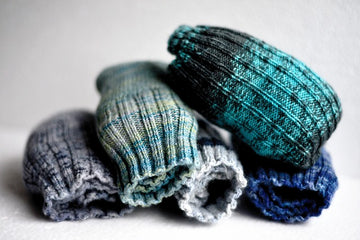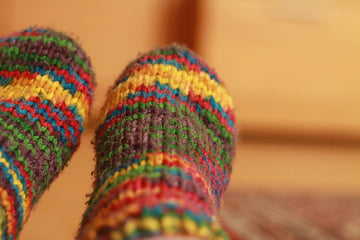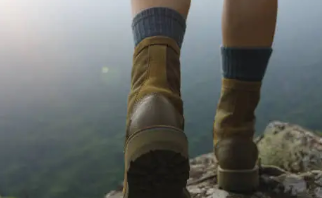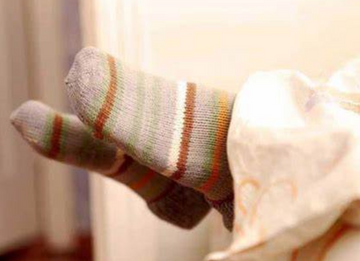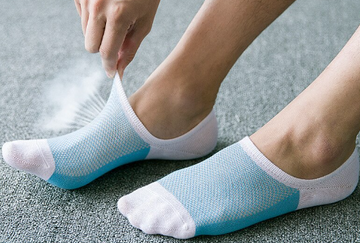
No-show socks, also known as invisible socks, have become a wardrobe staple for many. While trends may shift, no-show socks offer undeniable comfort and practicality, making them a versatile choice for a variety of situations. This article explores the reasons why no-show socks remain a popular footwear option, delving into their functionality and how to get the most out of them.
Guide to Men's No Show Socks
Guide to Women's No Show Socks
What shoes need no-show socks?
No-show socks are specifically designed to stay hidden while providing the comfort and hygiene benefits of wearing socks. They are ideal for a variety of shoe styles that typically expose more of the foot.
Classic Closed Back Flat Shoes:

Ballet Flats: No-show socks are perfect for ballet flats, as they provide comfort and prevent sweat without being visible.
Loafers: These socks keep your feet comfortable and dry while maintaining the sleek look of loafers.
Boat Shoes:

Deck Shoes: Often worn without visible socks, no-show socks are ideal for boat shoes, offering a sockless appearance with the benefits of wearing socks.
Espadrilles:

Summer Shoes: Espadrilles are often worn in warm weather, and no-show socks help keep feet cool and comfortable without being seen.
Ballet Flats:

Dressy Flats: These socks provide comfort and prevent blisters in ballet flats while staying hidden.
Canvas Shoes:

Casual Sneakers: No-show socks work well with canvas shoes, like Converse or Vans, offering a clean, casual look.
Slip-On Sneakers:

Casual Slip-Ons: Slip-on sneakers like TOMS or slip-on Vans are another great match for no-show socks, keeping the focus on the shoes.
Low-Top Sneakers:

Sporty Look: Low-top sneakers often look best without visible socks, and no-show socks provide the perfect solution for comfort and style.
Moccasins:

Comfort Shoes: For a more traditional style, no-show socks with moccasins keep feet comfortable without showing any sock material.
Are No Show Socks out of Style
No-show socks, also known as invisible socks, have stirred some debate regarding their place in current fashion trends. Here's a breakdown of why no-show socks remain a staple, their functionality, and how to make the most of them.
No-show socks are incredibly versatile, making them a reliable choice for various activities. They effortlessly transition from the office to the gym and casual outings, keeping feet dry and comfortable without visible fabric detracting from your outfit.
Achieve a sockless look with shoes like Converse sneakers, and opt for neutral colors for a professional style or mix in patterns for a trendy, fun appearance.
Neutral vs. Patterned: While neutral no-show socks remain a staple for professional settings, patterned and colorful socks are emerging as a trend. Though no-show socks may be less visible, they ensure your shoes and outfit shine without distractions.
Expression and Function: While no-show socks provide a clean look, taller socks with fun designs offer an avenue for personal expression. Depending on the occasion, both styles have their place in a wardrobe.
No Show Socks Remain Style
No-show socks are far from out of style. Their practicality and comfort make them indispensable, especially in warm weather or with certain types of shoes.
Ultimately, whether you opt for no-show socks or more visible options depends on your personal style and the occasion. Both types can be fashionable and functional, catering to different needs and preferences.
Investing in high-quality no-show socks ensures you enjoy their benefits without compromising on comfort or style. They might be "no style" in the sense of visibility, but they offer a sleek, polished look that allows your footwear and overall outfit to stand out.

Shop Our Best Crew Socks Collection
When not to wear no show socks?
No-show socks are versatile and useful, but there are certain situations where they may not be the best choice. Here are some scenarios when you should avoid wearing no-show socks.
- With Open-Toe Shoes
Inappropriate: No-show socks are not suitable for open-toe shoes, such as sandals or flip-flops. The socks will be visible and detract from the look of the footwear.
Style: Open-toe shoes are designed to be worn barefoot, highlighting the toes and the design of the shoe.
- In Cold Weather
Insufficient Warmth: No-show socks provide minimal coverage and are not ideal for keeping your feet warm in cold weather. Opt for thicker, taller socks that provide more insulation.
Practicality: In winter, it's better to wear crew or knee-high socks that cover more of your leg and retain heat.
- With Certain Types of Shoes
High Boots: Wearing no-show socks with high boots can be uncomfortable as the socks might slip and cause friction or blisters. Choose longer socks that stay in place and provide better coverage.
Formal Wear: With formal attire, such as dress shoes and suits, it's typically better to wear dress socks that match the formality of the outfit.
- During Intense Physical Activities
Support and Protection: For activities like hiking, running, or intense workouts, no-show socks might not provide enough support and protection. Athletic socks designed for these activities are usually a better choice.
Blister Prevention: Taller socks often offer better cushioning and prevent blisters by reducing friction.
- When Wearing Loose Shoes
Fit and Comfort: If your shoes are slightly loose, no-show socks might exacerbate the issue by not providing enough padding. Thicker socks can improve the fit and make the shoes more comfortable.
While no-show socks are practical and stylish for many situations, they are not always the best choice. It's important to consider the type of shoes you're wearing, the weather, and the activity you'll be engaging in to ensure you choose the most appropriate socks for the occasion.
Should I wear ankle or no show socks?
Choosing between ankle socks and no-show socks depends on several factors, including the type of shoes you're wearing, the activity you're engaging in, and the overall look you want to achieve. Here's a detailed guide to help you decide:
When to Wear No-Show Socks
Casual and Relaxed Events
Low-Cut Shoes: Ideal for low-cut shoes such as loafers, boat shoes, slip-ons, and low-top sneakers where you want a sockless look.
Warm Weather: Perfect for warm weather as they offer minimal coverage and keep your feet cool.
Style Considerations
Invisible Look: When you want your socks to be invisible and maintain a clean, minimalist look without any fabric showing.
Fashion: Suitable for outfits where you prefer the appearance of bare ankles.
Comfort and Breathability
Breathability: They provide good breathability and are less likely to cause your feet to overheat.
Heel Grip: Look for no-show socks with a silicone heel grip to prevent slipping and bunching.
When to Wear Ankle Socks
Read more:
Sporty and Active Scenarios
Sneakers and Athletic Shoes: Ideal for pairing with sneakers, running shoes, and hiking shoes, as they provide more coverage and protection than no-show socks.
Physical Activities: Better suited for running, hiking, gym workouts, and other physical activities due to their additional support and cushioning.
Cooler Weather
More Coverage: Provide more coverage than no-show socks, which can help keep your feet slightly warmer in cooler conditions.
Protection and Support
Ankle Support: Offer some ankle support and help protect against chafing and blisters, especially with high-top or mid-top shoes.
Comfort: Often more comfortable for extended wear due to the added cushioning and coverage.
Conclusion
Choose No-Show Socks When
- You want an invisible, sockless look.
- You're wearing low-cut shoes.
- The event or activity is casual and relaxed.
- It's warm, and you want maximum breathability.
Choose Ankle Socks When
- You're wearing athletic or hiking shoes.
- You're engaging in physical activities that require more support.
- The weather is cooler, and you need more coverage.
- You prefer additional protection against chafing and blisters.
Ultimately, the choice between ankle and no-show socks comes down to personal preference, the specific demands of your activities, and the look you want to achieve. Both types of socks have their place in a well-rounded wardrobe and can be chosen based on the context and requirements of your day.
What is another name for no show socks?
Yes, "no-show socks" are known by several other names, including:
- Invisible Socks: Emphasizing their hidden nature when worn.
- Secret Socks: Another term highlighting their discrete, almost invisible appearance.
- Liner Socks: Typically thin socks that provide a barrier between the foot and the shoe without being seen.
- Loafer Socks: Specifically designed to be worn with loafers or similar low-cut shoes.
- Footies: A casual term sometimes used for no-show socks, especially in reference to socks that barely cover the foot.
Each of these terms highlights the primary function of these socks: providing comfort and protection while remaining out of sight when wearing low-cut shoes.
Is it OK to wear no show socks with jeans?
Yes, it is perfectly acceptable to wear no-show socks with jeans, especially if you aim to show some ankle.
How to Wear No-Show Socks with Jeans
Cuffed Jeans:
Style: Cuffing your jeans is a stylish way to expose your ankles and the top of your shoes. This works well with no-show socks as they stay hidden and give a sleek look.
Shoes: Pair cuffed jeans with loafers, slip-on sneakers, or low-cut sneakers to highlight the no-show socks’ intended invisible appearance.
Hemmed Pants:
Tailored Look: Opt for jeans that are hemmed just above the ankle. This creates a polished and intentional look that works well with no-show socks.
Versatility: This style can be dressed up with oxfords or dressed down with casual sneakers.
Shorter Jeans:
Cropped Jeans: Jeans that naturally sit above the ankle are perfect for showing off some skin while keeping the socks invisible.
Footwear Choices: Ideal for pairing with a variety of shoes, from casual slip-ons to more formal loafers.
What color should no show socks be?
When selecting the color of no-show socks, consider both the look you want to achieve and the practical aspects. Here's a guide to help you choose the right color for your no-show socks.
Conservative Look
Black: A classic choice that works well with most shoes and outfits. Black no-show socks are versatile and hide dirt and stains effectively.
Navy: Another conservative option that pairs well with darker shoes and adds a subtle touch of color without standing out.
Adding a Pop of Color
Purple: Men's purple ankle socks can add a unique flair, especially if you want to incorporate a bit of personality into your outfit without being too flashy.
Colorful Options: Bright colors or patterned no-show socks can be a fun way to express your style. These are perfect for casual settings where you want to add some vibrancy to your look.
Why are my no show socks still showing?
If your no-show socks are still visible despite being designed to be hidden, there are a few common reasons why this might be happening. Here's a detailed look at why your no-show socks might still be showing and how to fix the issue.
- Improper Fit
Size Issues: If the socks are too big or too small, they won't stay in place properly and might slip, making them more visible.
Heel Fit: The fit around the heel is crucial. Socks that are too loose around the heel can slip down and become visible.
- Sock Design
Cut and Shape: Not all no-show socks are cut the same. Some might be higher than others, which can cause them to peek out of certain shoe styles.
Quality: Low-quality no-show socks might not have the right design or materials to stay hidden and in place.
- Type of Shoes
Shoe Style: Some shoes, even those meant for no-show socks, might have a lower cut that makes it hard to completely hide the socks. This is especially true for very low-cut shoes.
Fit of Shoes: Shoes that are too tight can push the socks up, causing them to show.
- Material and Elasticity
Stretch and Grip: Socks without sufficient elasticity or grip around the heel can slip and show. Look for socks with silicone grips or enhanced elastic bands around the heel area.
Solutions to Keep No-Show Socks Hidden
- Choose the Right Size
Proper Fit: Ensure you are buying the correct size for your feet. Refer to the size guide provided by the sock manufacturer.
Try Them On: If possible, try different brands and styles to find the best fit for your foot shape.
- Look for High-Quality Socks
Heel Grip: Select socks with silicone grips or enhanced elasticity around the heel to prevent slipping.
Anatomical Design: Opt for socks designed to match the shape of your foot, with specific left and right fits.
- Match Socks to Shoes
Shoe Compatibility: Pair your no-show socks with shoes that have the appropriate cut. Some very low-cut shoes may require specialized ultra-low cut socks.
Avoid Tight Shoes: Ensure your shoes fit properly and are not too tight, as this can push the socks up and make them visible.
- Material and Construction
Quality Material: Choose socks made from high-quality, breathable materials that have good elasticity.
Reinforced Edges: Socks with reinforced edges tend to stay in place better and are less likely to slip.
If your no-show socks are still showing, it’s likely due to issues with fit, sock design, shoe compatibility, or material quality. Ensuring you have the right size, selecting high-quality socks with good heel grip, and matching them appropriately with your shoes can help keep them hidden and provide the comfort and style you’re aiming for.
When were no-show socks popular?
The early 2000s marked the rise of no-show socks, coinciding with the popularity of skinny jeans and the fashion trend of wearing sockless footwear like ballet flats. Since then, no-show socks have continued to be a practical and stylish choice for various shoe styles, offering wearers the comfort and convenience of socks while maintaining a minimalist, sockless look.
Why do no show socks slip off?
No-show socks can slip off for various reasons, but one common cause is the lack of a proper heel grip. Here’s why your no-show socks might be slipping off and how silicone heel grips can help.
Natural Movement of the Foot:
Heel Movement: Your heel naturally rises and falls as you walk, which can cause the inner heel of the shoe to pull at your socks.
Friction: Without adequate grip, the socks may slide down and bunch up under your foot.
Poor Fit:
Size Issues: If the socks are too large or too small, they may not conform properly to your foot, increasing the likelihood of slipping.
Loose Elastic: Worn-out elastic or poor-quality socks may not hug your foot securely.
Incorrect Design:
Lack of Grip: Some no-show socks are designed without features like silicone heel grips, making them prone to slipping.
Low-Cut Design: Socks with a very low cut may not provide enough coverage to stay in place.
Final Words
No-show socks are far from out of style. Their ability to provide comfort and a streamlined look, especially in warm weather or with certain shoe styles, makes them a valuable addition to any wardrobe. Ultimately, the choice between no-show socks and other sock styles comes down to personal preference, the occasion, and the specific footwear you're wearing. Both can be fashionable and functional, catering to different needs and aesthetics. Investing in high-quality no-show socks ensures you can enjoy their benefits without sacrificing comfort or style.




